What can you call the Autocephalous Türk Orthodox Church? A nonentity, a grand theft, an anomaly, a political expedient – they all apply. Formed in 1922 in the nationalist euphoria after the eviction of the Greek army, Pavlos Karahisarithis decided that he was the Patriarch Papa Eftim and formed the Autocephalous Patriarchate of Anatolia. He repeatedly invaded the Greek Orthodox Patriarchate in Fener with his supporters. In 1924, he made the politically astute decision to carry out church services in Turkish. He changed his name to Zeki Erenerol and managed to gain a reasonable amount of support from elements of the new republican government. He was given the Church of Meryem Ana in Galata as his headquarters. There were few Greeks remaining in the city after the enforced population exchange and the Erenerols were exempted from exile.
With few Christians left in Turkey and those who stayed deciding to remain affiliated with the Greek Patriarchate, Papa Eftim had difficulty in gaining and maintaining a congregation. In the 1930s, some 70 Garguaz – Christian speakers of a Turkish dialect who lived in Bessarabia – were offered a deal to settle in the Marmara area and become part of the Türk Orthodox Church. Within a few years, they had converted to Islam and left Eftim with no followers. This and subsequent efforts to attract adherents from what could be seen as the wider Turkish community gained the church support from right-wing nationalists. The most prominent member of the Erenerol family, the only people who can remotely be considered as Türk Orthodox, is Sevgi Erenerol. She is serving a life sentence in prison for her enthusiastic participation in the Ergenkon conspiracy, the ultranationalist network of assassins, warlords, politicians and generals that controlled Turkish affairs in the late 20th century. This site [4] from 2008 details one version of the connection between Ergenekon and the Türk Orthodox Church.
Church services ended in 2008 after the widespread allegations that the church had served as a sort of headquarters for Ergenekon. They began again at some stage and by the time this article [6] was published, attendance on Sundays had risen to a congregation of two Erenerols. To give some idea of the incestuous nature of the Turk Orthodox Church, Sevgi Erenerol is the granddaughter of the first Patriarch, the niece of the second, the daughter of the third and the sister of the fourth.
The Patriarchate is the rather lovely Church of Meryem Ana in Karaköy (41.025099,28.978889). This was founded by the Greek Orthodox community of Kaffa (Crimea) and was hence named Santa Maria de Kaffa or Panagia Kaphatiani. Its courtyard bears a prominent banner saying ‘Ne Mutlu Türküm Diyene’. This means ‘happy is the person who says I am a Turk’. This is a nationalist slogan from the early republican era. This is usually written in whitewashed rocks on mountains overlooking Kurdish villages by Turkish conscripts to tell the Kurds that they don’t exist. Here it is written to tell the Greeks that they should be Turks. Fairly obviously, the Ecumenical Patriarchate has never recognised the existence of the Türk Orthodox travesty and still sees the churches as being Greek Orthodox.
The Church of St Nicholas (Aziz Nikola) taken over by Papa Eftim after the 1955 anti-Greek riots. It was damaged in the earthquake of 1999 and is closed for repair. It is partly roofless in May 2014 and looks very sad (41.024482,28.978283). With no congregation and no likelihood of the Erenerol family loosening their hold on this ceremonial ruin, it looks as if it will slowly crumble into the earth.
The Church of Saint John (Aya Yani or Aziz Yahya 41.02507,28.978018) was also taken over by the Türk Orthodox Patriarchate after the riots. Obviously, there was no congregation to fill it so it was rented to the Assyrian Church for a while. I’m not sure whether anyone is using it at the moment. Some sources give the dedication of this church as St John Chrysostomas [9], others as St John the Baptist (Karaca, Freely). It may have been a politically motivated change in dedication. The Divine Liturgy of John Chysostom is the standard service of the Greek Orthodox community and much importance is given to its exact wording. Clearly, saying the liturgy in Turkish language would mean John Chrysostom’s liturgy no longer being used. Changing the dedication to the better-known and less controversial John the Baptist may have avoided some issues in the Orthodox community.
This final story sums up the Türk Orthodox charade. In 1926, the patriarch took over the Church of Christ. In 1947, the Turkish government announced that the church was to be returned to the Greek Orthodox community. Unfortunately, a road was widened and the church was demolished. Compensation was paid to the Türk Orthodox Patriarchate.
On the first Sunday in October (2014), I was breakfasting in the excellent OPS Cafe just opposite the Patriarchate when I heard the bells of the Panaghia Kaphatiani. For the first time, I found the church open and the atmosphere of a normal church prevailed. There were people lighting candles and praying before the altar and priests preparing the host. When the service got under way, there were seven women in the congregation. Several of them were young and giggly, as if this was their first time in church. The liturgy was conducted by four ecclesiastical personnel. It was odd to hear the ritual spoken in Turkish. Still, it was a genuine church service in a church that all sources had led me to believe was defunct. I’ll go and talk to the caretaker in the near future to find out what is happening in the world of the Türk Orthodox Church.
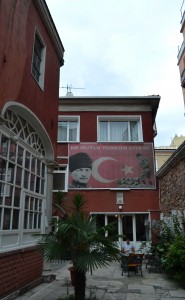
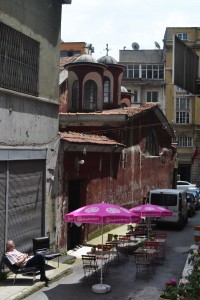
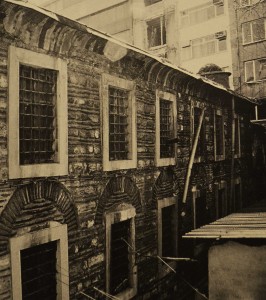
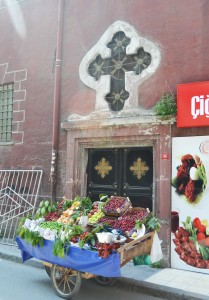
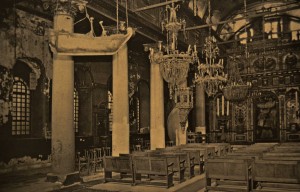
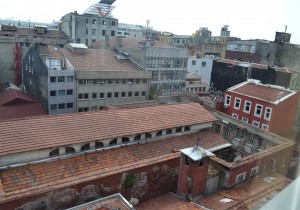
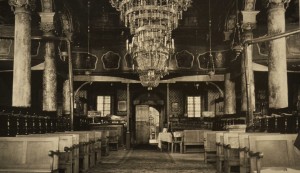
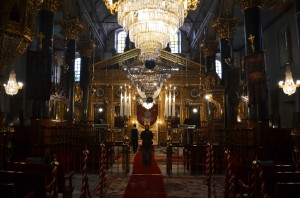
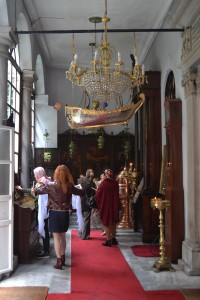
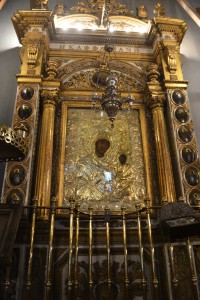
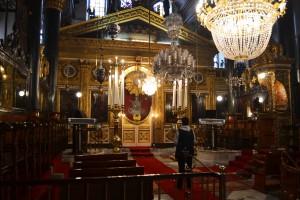

2 Comments To "The Türk Orthodox Patriarchate"
#1 Pingback By Enormousfish | Index | Adam Kaya Heskith | Author and Writer | Enormousfish On June 30, 2014 @ 12:38 pm
[…] Autocephalous Türk Orthodox Church […]
#2 Pingback By Enormousfish | Pera/Galata | Adam Kaya Heskith | Author and Writer | Enormousfish On October 26, 2014 @ 8:52 pm
[…] […]